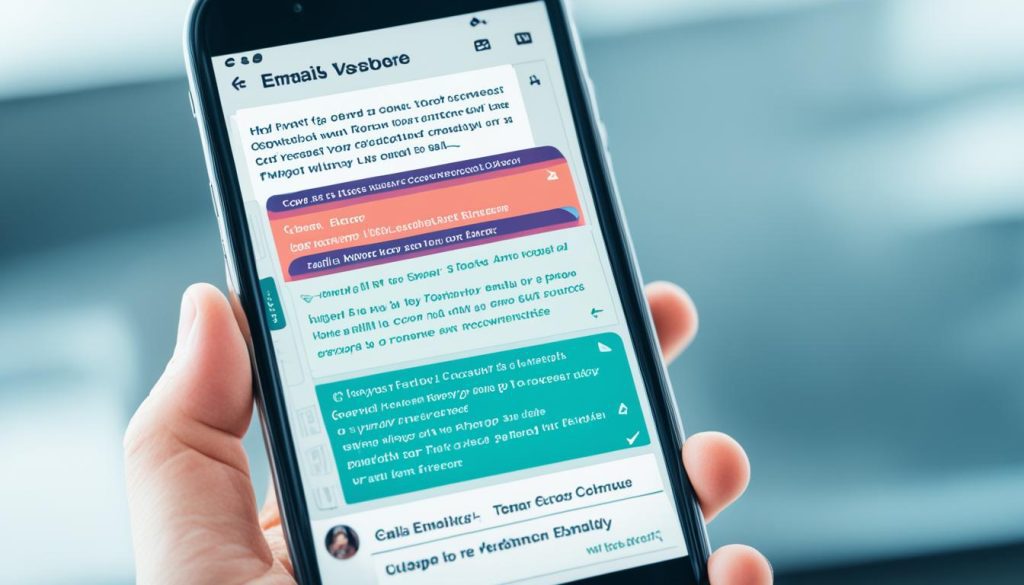Email marketing is a key way for businesses to reach their audience, build connections, and boost sales. Mastering it can significantly help your business grow.
This article dives into email marketing, discussing what makes campaigns work. It gives you practical tips and methods to improve your email marketing.
We’ll talk about knowing your audience and crafting engaging content. Plus, we’ll cover the importance of mobile optimization and personalization.
How to Use Email Marketing for Business
- Segment your email list based on demographics, behaviors, and preferences to send targeted and relevant content.
- Create engaging and valuable content that aligns with your brand’s voice and use compelling subject lines to grab attention.
- Optimize your emails for mobile devices to enhance the user experience.
- Personalize your emails by using recipient’s names, tailored content, and targeted recommendations.
- Test different elements of your email campaigns and analyze metrics to refine your strategy.
Know Your Audience
Understanding who you’re emailing is key to email marketing success. Segmenting your list based on things like age and what they like makes your emails more relevant. This increases the chance they will engage or buy something.
By dividing your audience, you can send messages that really speak to them. For instance, a clothing shop can target emails based on gender, age, or what they’ve bought before. This way, you can suggest items they’re likely to love.
When emails match interests, customers are happier. They feel seen and are more likely to act, like buying or joining a webinar. This is good for both of you.
Segmenting lets you see what works best, too. By looking at which emails get opened or clicked the most, you can fine-tune your approach. This helps your email marketing get better over time, driving more sales and sign-ups.
| Benefits of Email List Segmentation | Examples |
|---|---|
| Increased engagement | Segmenting your list by location and sending personalized event invitations to subscribers in specific cities |
| Higher conversion rates | Segmenting your list based on past purchases and sending targeted product recommendations |
| Improved customer satisfaction | Segmenting your list by buyer persona and sending content that resonates with each segment’s specific pain points and interests |
Craft Compelling Content
Email marketing success hinges on offering valuable content. Your emails need to bring something useful to your audience. This could be in the form of informative articles, unique offers, or fun stories. Offering engaging content that fits your brand’s style helps grab attention. This encourages people to interact with your emails more.
Create attractive subject lines to catch your audience’s eye. A good subject line makes people curious and eager to open your emails. Try using interesting words, posing intriguing questions, or suggesting urgency. Test different subject lines to find what your audience likes best.
It’s crucial to keep a consistent brand voice in your email content. This voice shows your business’s personality and values. It helps connect with your audience. Make sure your email content reflects whether your brand is authoritative or friendly and casual.
Successful email engagement is all about relevant and valuable content. Offer your audience things they appreciate, like learning material, special discounts, or engaging stories. By regularly providing great content that fits your brand and interests your audience, you strengthen email interactions. This helps build durable bonds with your subscribers.
Optimize for Mobile
Most email opens happen on mobile devices. It’s key to make sure your emails look good on them. Use responsive design and short, easy-to-read content. This makes it better for people to read your emails when they’re moving around.
Emails should look right no matter the device, like smartphones or tablets. This means your content resizes to fit screens perfectly. It gives users a great view of your emails.
Responsive design is vital for mobile-friendly emails. It adjusts your email’s layout so it’s easy to read and tap on, even on small screens.
It’s also smart to write brief and clear content. People on mobile have less time and a shorter focus. Make your point fast. Use simple words, bullet points, and short paragraphs. This improves how easy it is to read your emails.
Optimizing emails for mobile leads to a better experience. Your readers are more likely to interact with your emails and do what you ask. This can help your business grow.


Personalization Matters
Email marketing gets a boost with personalization. Crafting personalized emails that meet your recipients’ interests can boost engagement and relationships. It’s about tailoring your messages to them.
Using the recipient’s names is a simple yet effective way to personalize. Adding names to the email’s subject or body brings a personal touch. It signals that you see them as individuals, not just entries in a database.
But there’s more to personalization than names. Taking things further by offering targeted recommendations enhances its impact. With data, you can understand what each person likes. Then, you can send them exactly what they find interesting.
Imagine you run an online store selling sports gear. For someone who often buys workout clothes, you could suggest new fitness wear. This shows you’re attentive to their preferences, making your brand more meaningful to them.
Emails can also have dynamic features for a tailored experience. These might include suggestions based on past buys, local deals, or custom bundles. This adds to the email’s personal feel.
Benefits of Personalization
Personalized emails bring undeniable perks:
- Higher engagement: Custom messages grab attention. People are more likely to engage with emails that interest them. This means more clicks and active interaction with your brand.
- Improved conversions: With specific offers just for them, people are more inclined to buy. Personalized content creates urgency and excitement, prompting action.
- Enhanced customer loyalty: Regular personalized experiences build loyalty. Customers stick with brands that feel personal. They’ll keep buying and even recommend your business.
Clearly, personalization is key in email marketing. It covers using names, sharing relevant advice, and offering tailored content. This approach builds deeper connections with your audience, leading to great results for your company.
| Personalization Techniques | Benefits |
|---|---|
| Using recipient’s names in subject lines and email content | Creates a sense of familiarity and makes emails feel personalized |
| Sending targeted recommendations based on recipient’s preferences | Increases engagement, click-through rates, and conversions |
| Utilizing dynamic elements to create a customized experience | Enhances customer loyalty and drives repeat purchases |
By adopting these personalization methods, you’ll maximize your email marketing’s impact and see your business grow.
Test and Analyze
Email marketing constantly changes, so testing is vital. By trying out different elements, you’ll discover what works best. Here are the main things you should test and look into:
Subject Lines
The subject line is the first thing people see. A good subject line can really boost how many people open your emails. Try out various lengths, styles, and keywords to find what clicks with your readers. Make sure it’s to the point, relevant, and grabs attention.
Content Formats
How you format your content affects how people interact with it. Try different styles, like simple text, HTML, or even interactive elements, to see what your audience prefers. Adding pictures, videos, or GIFs might get more people engaged.
Sending Times
When you send emails matters as much as what’s in them. Try sending your messages at various times or days to see when you get the best response. Think about when your readers are likely to check their emails. This will help you connect better.
Analyze Metrics
Making decisions based on data is key in email marketing. Look at open rates, click rates, and other important metrics. This helps you understand what strategies work. By identifying trends, you can fine-tune your approach to get better results.


Keep testing and reviewing your email campaigns to improve them. Experimentation helps you stay ahead and achieve better engagement and success. It’s crucial for doing well in the digital world.
Build Trust with Consistency
Consistency is very important for building trust with your audience. In email marketing, it’s crucial to have a clear schedule and stick to it. This shows you are dedicated to regular communication and being reliable, which builds trust in your brand.
It doesn’t matter if you send out emails every week, once a month, or every two weeks. Keeping a steady flow shows you care about your subscribers’ time. It also keeps your business in their minds, so they always look forward to your messages.
Regular emails do more than just show you’re reliable. They also make your relationship with your subscribers stronger. You get to share valuable content, exciting news, and special offers. All of these efforts help in creating a loyal group of customers.
Benefits of Consistent Communication in Email Marketing
- Increased Engagement: Keeping in touch regularly makes your audience stay interested in your brand. Sending engaging content regularly encourages them to read and interact with your emails.
- Improved Brand Recognition: Staying in touch often keeps your brand fresh in your subscribers’ minds. This enhances brand recognition and makes them think of you when they need what you offer.
- Enhanced Customer Trust: Being consistent builds trust. When subscribers get regular emails from you, they see your brand as dependable. This leads to stronger connections and more loyal customers.
Adding a consistent emailing schedule to your marketing plan greatly helps your brand’s reliability and success in the long run. By focusing on regular communication, you gain trust, strengthen relationships with customers, and increase engagement.
| Email Frequency | Benefits |
|---|---|
| Weekly newsletters | – Keeps your audience up-to-date with the latest news and information – Establishes a routine communication channel – Builds anticipation for your next email |
| Monthly updates | – Provides a comprehensive overview of your business and offerings – Allows for more in-depth content that educates and informs – Demonstrates your commitment to consistent communication |
| Bi-weekly promotions | – Offers exclusive discounts and deals to your subscribers – Creates a sense of urgency and encourages immediate action – Helps drive sales and boost customer engagement |
Compliance and Respect Privacy
Keeping a good brand name means respecting your audience’s privacy. Make sure they’ve allowed you to email them. Always offer clear ways to sign up or unsubscribe.
Emails should only go to people who said yes to your messages. This keeps you in line with laws like GDPR and CAN-SPAM. Plus, it builds trust with your audience.
Your sign-up process must be easy to spot and use. Explain what you’ll send and how often. Make it simple for people to stop receiving emails if they want to.
Respecting privacy means sending emails only with permission. Provide clear sign-up and leave options. This builds strong connections with your subscribers. It keeps your email efforts both legal and effective.
Opt-In Tips:
- Place opt-in forms in visible and prominent locations on your website
- Clearly state the benefits of subscribing to your email list
- Offer incentives such as discounts or exclusive content for opting in
- Use double opt-in confirmation to verify subscribers’ interest
Opt-Out Tips:
- Include an unsubscribe link in every email
- Make the opt-out process simple and user-friendly
- Provide alternative communication channels for those who no longer wish to receive emails
By respecting audience preferences and following best practices, your email marketing will be respected, compliant, and successful.


Utilize Email Marketing Tools
Using the right tools can hugely boost your email campaigns. They offer automation, pre-made templates, and analytics to streamline your work. This way, you save time, boost efficiency, and get better results.
Automation for Effortless Campaigns
Email tools feature automation that makes sending mails easy. You can set workflows that trigger actions based on user behavior. This ensures timely emails to the right audience without you having to do it manually.
Templates for Professional and Consistent Emails
Making good-looking emails can be tough. But, email tools have tons of templates you can use. These templates are customizable to fit your brand. They keep your emails looking professional and save you time.
Analytics for Data-Driven Optimization
Analytics are key for improving your email strategy. They provide insights on campaign performance, from open rates to conversions. This data helps you test and enhance your emails for better engagement.
By using tools that offer automation, templates, and analytics, you elevate your email strategies. These tools simplify your process and help optimize your campaigns. Don’t miss their benefits; start using email marketing tools today to grow your business.
Conclusion
Email marketing is key for effective email marketing and critical for business growth and engagement. With the right strategies and practices, you can unlock email marketing’s full potential. This helps to build stronger customer relationships and reach business success.
Understanding your audience is the first step. Segment your email list and send tailored content to boost engagement and drive conversions. It’s also crucial to create compelling content that offers value. Use your unique brand voice, make engaging subject lines, and offer special deals or informative articles to keep your audience hooked.
In our mobile-focused world, ensuring emails are mobile-friendly is a must. Emails should be optimized for all devices to provide a smooth user experience. Adding a personal touch to your emails is essential too. Use recipient names, customize content based on their interests, and suggest products or services they might like to create a stronger bond.
It’s important to test and analyze your email campaigns to improve their performance. Try different subject lines, content styles, and sending times to increase opens, clicks, and conversions. Being consistent in communicating with your subscribers builds trust and reliability. Clearly set how often you’ll send emails and always provide valuable info.
Always respect privacy and follow email marketing laws to protect your brand’s reputation and adhere to regulations like GDPR and CAN-SPAM. Use email marketing tools to simplify your campaigns, automate tasks, and use pre-made templates. By tapping into email marketing’s power and using these strategies, you can enhance business growth and engagement.


